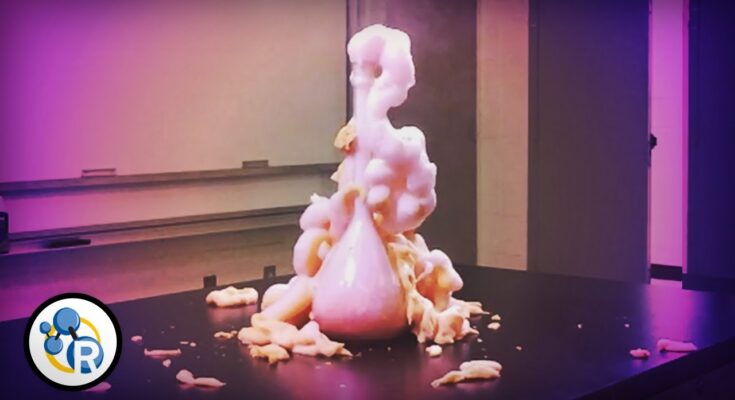Elephant Toothpaste Recipe: Elephant toothpaste is a fun and exciting science experiment that produces a massive foamy eruption resembling toothpaste being squeezed from a giant tube. This experiment is not only visually impressive but also a great way to introduce kids and adults to the wonders of chemistry.
Why is it Called “Elephant Toothpaste”?
The name comes from the foamy, bubbly reaction that looks like an enormous amount of toothpaste being squeezed out—enough for an elephant! While it isn’t real toothpaste and shouldn’t be used for brushing, the reaction is a fun way to demonstrate scientific principles.
Science Behind the Reaction
The experiment is based on the rapid decomposition of hydrogen peroxide (H₂O₂) into water (H₂O) and oxygen gas (O₂). A catalyst, such as yeast or potassium iodide, speeds up the reaction, causing an explosion of oxygen bubbles trapped in soapy foam. This reaction showcases the power of catalysts in chemistry.
Materials and Ingredients Required
Essential Ingredients
To perform this experiment, you’ll need:
- Hydrogen Peroxide (3% or 6%) – The key ingredient for the reaction.
- Dry Yeast – Acts as a catalyst to break down the hydrogen peroxide.
- Warm Water – Helps activate the yeast.
- Liquid Dish Soap – Traps the released oxygen, creating foam.
- Food Coloring (Optional) – Adds a fun visual effect.
Safety Equipment Needed
Since this experiment involves a chemical reaction, safety is important. Make sure to have:
- Safety goggles
- Gloves (especially for higher concentrations of hydrogen peroxide)
- Protective clothing or an apron
Alternative Ingredients for Different Versions
- Potassium Iodide (KI) Instead of Yeast – Creates an even faster reaction.
- Hydrogen Peroxide (12% or 30%) – For a bigger, more dramatic reaction (requires extreme caution).
- Baking Soda Instead of Yeast – Will not work as effectively, but still produces some reaction.
Step-by-Step Guide to Making Elephant Toothpaste
Step 1: Prepare Your Workspace
Find a large surface that is easy to clean, like a kitchen counter or a plastic tray. Place an empty plastic bottle in the center of a tray to contain the foam.
Step 2: Mix the Hydrogen Peroxide and Soap
Pour about half a cup (120ml) of hydrogen peroxide into the plastic bottle. Add a few squirts of liquid dish soap and gently swirl the bottle to mix them together.
Step 3: Add Food Coloring (Optional)
If you want colorful foam, add a few drops of food coloring directly into the bottle. Swirl the mixture again for an even distribution of color.
Step 4: Prepare the Yeast Mixture
In a separate cup, mix one tablespoon of dry yeast with three tablespoons of warm water. Stir well and let it sit for a minute to activate the yeast.
Step 5: Pour the Yeast into the Bottle
Quickly pour the yeast mixture into the hydrogen peroxide solution and step back!
Step 6: Observe the Reaction!
Almost instantly, a massive column of foam will start flowing out of the bottle. The reaction continues for a few minutes, creating a thick, warm foam due to the release of oxygen gas.
Understanding the Chemical Reaction
Role of Hydrogen Peroxide
Hydrogen peroxide naturally breaks down into water and oxygen, but this process is usually slow. The yeast speeds up the breakdown.
Importance of Yeast as a Catalyst
Yeast contains an enzyme called catalase, which helps decompose hydrogen peroxide almost instantly, causing the foam to form rapidly.
Why Does the Reaction Foam So Much?
The dish soap traps the released oxygen, forming thousands of bubbles that result in the huge foamy eruption.
Variations of Elephant Toothpaste Experiment
- Stronger Hydrogen Peroxide (12% or 30%) – Creates bigger, hotter foam.
- Potassium Iodide Instead of Yeast – A much faster and more intense reaction.
- Different Bottle Shapes – Changes the way the foam erupts.
Safety Precautions and Best Practices
- Use gloves and goggles if working with stronger hydrogen peroxide.
- Avoid direct skin contact with the foam.
- Perform the experiment outdoors or on a surface easy to clean.
Fun Ways to Use the Experiment
- Use it for science fair projects.
- Teach kids about chemical reactions.
- Make it a fun party trick!
Troubleshooting Common Issues
- Foam isn’t expanding? – Try using fresher yeast or higher concentration peroxide.
- No reaction? – Ensure your yeast is properly mixed with warm water.
- Not enough foam? – Increase the amount of dish soap.
FAQs about Elephant Toothpaste Recipe
What is the elephant toothpaste experiment?
The elephant toothpaste experiment is a popular science activity that demonstrates an exothermic chemical reaction, producing a large foamy substance that looks like toothpaste being squeezed from a tube. It’s called “elephant toothpaste” because the quantity of foam could theoretically clean an elephant’s teeth!
What materials do I need for the elephant toothpaste experiment?
You’ll need hydrogen peroxide (the higher the concentration, the more dramatic the reaction), dish soap, active dry yeast as a catalyst, warm water, food coloring (optional), and a large container to catch the foam.
How do I make elephant toothpaste?
- In a small container, mix warm water with yeast and set it aside for about one minute.
- Pour hydrogen peroxide into a large bottle or jug.
- Add several drops of food coloring and a good squirt of dish soap to the hydrogen peroxide and swirl gently to mix.
- Pour the yeast mixture into the hydrogen peroxide solution, step back, and watch the foam rise!
Is the elephant toothpaste experiment safe to do at home?
Yes, it is safe with proper precautions. Use a low concentration of hydrogen peroxide (3% is typical for household use) to keep the reaction manageable and less hot. Always wear safety goggles and gloves to protect from splashes, and conduct the experiment in an area that’s easy to clean.
Can children perform the elephant toothpaste experiment?
Children can participate in this experiment under adult supervision. It’s a fantastic way to introduce them to basic chemistry concepts and safe laboratory practices.
What is happening chemically during the elephant toothpaste reaction?
The yeast acts as a catalyst to break down the hydrogen peroxide into water and oxygen gas. The dish soap catches the escaping oxygen bubbles, creating a mass of foam. The reaction is exothermic, meaning it releases heat.
Why does the mixture get warm?
The breakdown of hydrogen peroxide into water and oxygen is an exothermic process, which releases heat, causing the mixture to warm up. This is typical for many chemical reactions that release energy.
What can I do to make the reaction more impressive?
Using a higher concentration of hydrogen peroxide (such as 6% or higher, available from beauty supply stores or online) will produce more foam and heat. However, higher concentrations should be handled with extra care to avoid skin and eye irritation.



